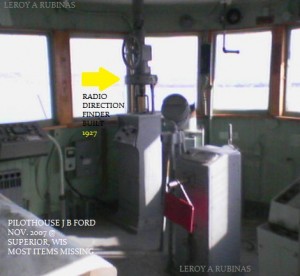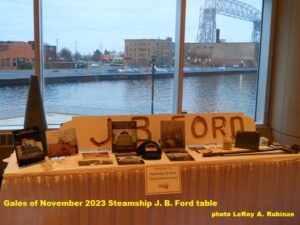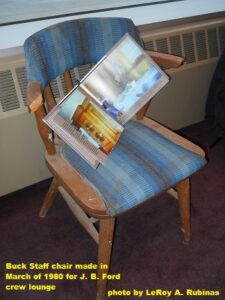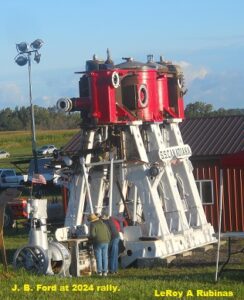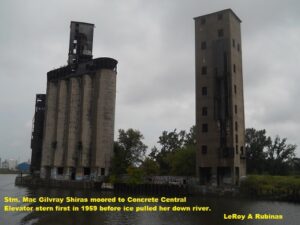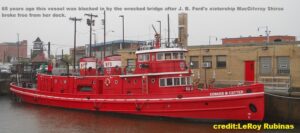Vessel History
The J. B. Ford was built by American Shipbuilding Company in Lorain, Ohio on the Black River, over the winter of 1903-1904. On December 12, 1903 the J. B. Ford was launched at noon. The ship was Christened the steamer Edwin F. Holmes by Miss Arla Elizabeth Hawgood, and in ceremonies that followed Captain James Owen was given first command. The Hawgood family and guests had arrived from Cleveland,Ohio to Lorain via a special railroad car of the Nickel Plate RR.
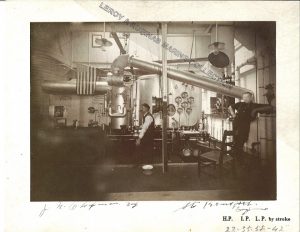
On January 22, 1904 heavy rains caused wide spread flooding of Ohio and PA. Ice dammed up around the Nickel Plate RR turntable bridge on the Black river causing it to be washed out. The bridge tender had to be rescued and the ice flow caused wide spread damage. The tug Pankrats caught fire and sank, the tug Gull sank after the steamer Holden pinned it against the pier until it sank in the river. The tug Brazier was washed out onto Lake Erie. The Holmes tied up along the shipyard swung across the river burying her bow into the muddy bank. The yard, as well as a steel mill, were closed for three weeks due to flooding. The local fire engine pumper was dispatched to pump out the shipyard buildings. On February 5, 1904 a gang of shipyard workers dug out the bow of the Holmes.
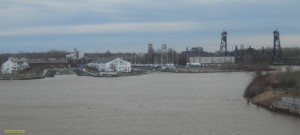
Today the shipyard has been re-developed into housing with two steel mills remaining on the Black River. The bridge has been replaced with a newer RR lift bridge.
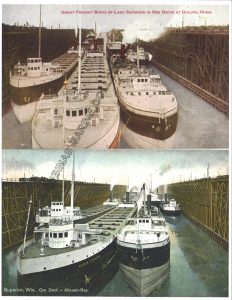
The Edwin F. Holmes entered the bulk cargo trades on the Lakes in 1904. On July 19, 1904 in the Duluth, MN harbor the Holmes was backing away from the Northern Coal dock unassisted by tugs, when a wind caught her hull and she drifted into the Booth s Line passenger steamer America. One of the Holmes anchor s touched the America crushing in five cabins. The America s hull was not damaged, so she was able to continue service for chartered groups. The Holmes left Duluth,MN the next day. The Steamer America exists today as part of an underwater preserve on Isle Royale Lake Superior.
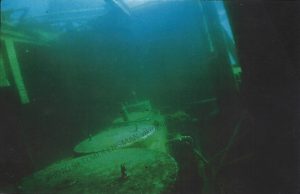
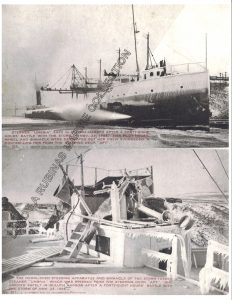
The gales of November 28-30th ,1905 damaged many ships. In Duluth, MN the storm is remembered as the Mataafa Storm as thousands were unable to help the crew of this troubled ore carrier which sank and broke in half just yards off the pier entrance. During this time many mariners lost their lives in cold icy waters of Lake Superior. The Edwin F. Holmes left Lorain up bound loaded with coal for Duluth,MN. On November 28th she is listed as passing Port Huron,MI around 1pm. Later that day 2:30PM the Steamer Charles M. Warner which lasted up until the mid-1990 s as the Lakewood, also headed up bound onto Lake Huron, but her crew was blinded by a snow storm and grounded on Nine Mile Point near Sheboygan,MI. The Holmes made it through the Soo Locks out onto Lake Superior, telegraph messages listed her as overdue on November 30th, the same day her sistership Umbria of the same dimensions and company but from the Cleveland yard arrived in Duluth with a badly damaged bridge.
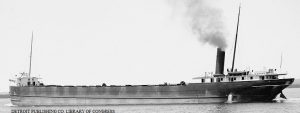
The crew brought the Umbria into port by steering the ship from the emergency steering station located behind the smoke stack. The Edwin F. Holmes arrived in Duluth the next day on December 1, 1905. The Hawgood fleet expanded with more new ships like the Salt Lake City(Chester A. Congdon) and the Henry B. Smith. Captain James Owen was given command of the latter. In 1913 on November 11th another fierce gale claimed the lives of many mariners and lake ships.
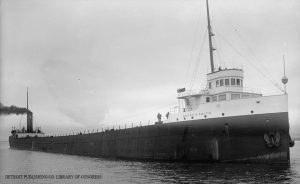
The Henry B. Smith was lost with all hands in this storm. Captain James Owen first Captain of the J. B. Ford remains part of Lake Superior. In 1916 after many court appeals to the US District Court in Cleveland,Ohio the Edwin F. Holmes, and her sister ship were sold with 9 other Hawgood vessels to Harry Coulby of the Pittsburg Steamship company. The court found evidence of secret commissions paid to the shipbuilding company to have new ships built for them rather than other companies which were seeking to keep up with rising demand for new ships to move bulk cargos. The Edwin F. Holmes was re-named the E. C. Collins, and her sister ship Umbria was named the Mac Gilvray Shiras.
In 1927 the E. C. Collins at this time a Pittsburg Steamship steamer named for the Transportation Manager of that fleet went to Toledo Shipbuilding Company in Toledo, Ohio to be rebuilt. The Collins received new boilers, a radio direction finder located on the bridge among other updates. The square windows on the forward and aft houses were updated with portholes. The crew quarters located on gangway level near the steering engine were moved to a new house located on the main deck in between cargo hatches. The Collins and the Shiras former Umbria would look this way up to the 1950’s.
World Wars 1 & 2 came and these ships continued to deliver vital coal, iron ore, and grain to meet America s demand. In World War 2, Pittsburg Steel acquired newer, faster, larger ore carriers, and the pair were sold in 1944 to Kinsman Transit Company(Steinbrenner Fleet). The vessels mainly worked in and around Buffalo & Cleveland. The E.C. Collins would lay-up during the winter months on the Buffalo River or in the outer harbor. Ships were loaded with grain to keep the flour mills producing when shipping closed for the winter season. In February 1956 the Huron Cement Company of Detroit ,MI purchased the Collins to be converted into a cement carrier. The ship was tied up near the Seneca elevator on the Buffalo River. Over the winter of 1958-1959 in Sturgeon Bay, WI, the Collins was converted to a self unloading cement carrier, equipped with a Norberg diesel generator to power her self unloading gear.
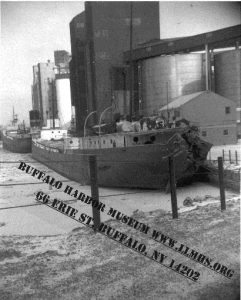
On January 21, 1959 fifty years ago her sister, the Mac Gilvray Shiras, was docked near the Concrete Central elevator on the Buffalo river. Gale winds and rain pulled her free from the dock. The Shiras navigated three right-angle bends in the river unassisted by tugs or crew. She bore down stern first to another grain boat. The Shiras collided with the Michael K.Tewksbury which then continued down the river until it was stopped by the Michigan Ave lift bridge. The Lift bridge towers fell one crashing into the river and the other blocking the Buffalo Fire Dept. vessel Cotter. A huge pulley from the bridge landed on top of an unsuspecting Ford Fairlane crushing it s trunk. Later in 1959 the Shrias was given up for scrap, the aft end of the carrier housing it’s steering engine and rudder were badly damaged.
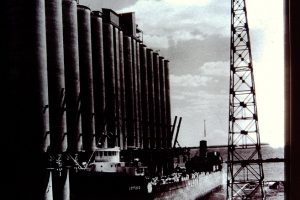
The J. B. Ford continued service as a cement carrier, her hull a green with gray decks and white deck houses. Huron Cement became part of National Gypsum. The Ford spent many more winters laid up in Buffalo housing a load of cement instead of grain. On Feb. 16, 1967 Buffalo was blasted with a 90mph wind storm, killing three when a bar collapsed at 6 South Park Street. Much paper debris ended up on the streets, and the ship keeper s stove vent located on the boat deck was lost in the storm. Oldman Boiler Works repaired the vent.
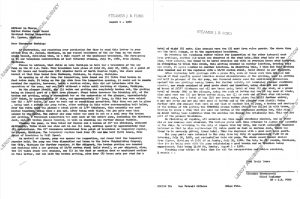
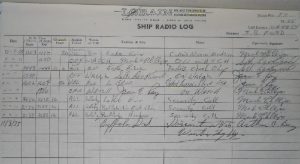
During the winter of 1975-1976 as the country prepared for the Bi-centennial, Nicholson & Hall Corp. of Buffalo,NY was commissioned to convert the coal fired steamship to burn heavy fuel oil. It was a cold three month project according to M. Padia, then project manager, who is now the current president of the company. The J.B. Ford s coal bunker was removed and three grain elevator like fuel cells were installed in the ship along with fuel burning boiler fronts.
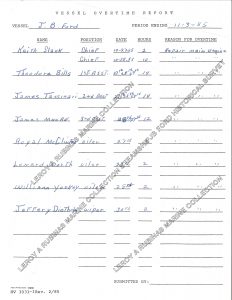
In 1985 the season was very damp due to much rain. On November 8th 1985 the J. B. Ford unloaded a cargo of cement into the E. M. Ford built in 1898 serving as a storage hull in Milwaukee,WI. On November 15 the J. B. Ford was laid up for the season in Milwaukee. The ship was full of cement for the winter season, and she was tied to the E. M. Ford. Interviews with Bill Kulka(engineer 1984), and Rodney(fireman 1984) former crew; suggest that in 1985 the steam engine suffered damage when an operator did not blow condensation out of the steam line heading to the triple expansion steam engine. A water droplet propelled by steam cracked the high pressure cylinder damaging the engine. The engine was repaired, but was not functioning the way it did prior to the damage.
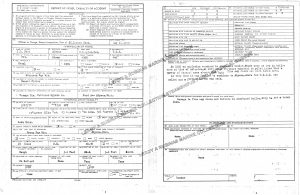
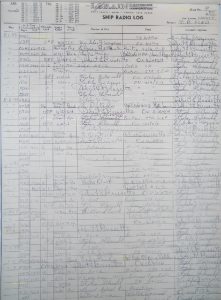
Another interview with Larry B. son of one of the last captains of the ship stated one of the reasons why the J.B. Ford was converted to oil firing was due to it s thick black smoke from her stack. The ship is rumored to have been not welcome in the town of St Joesph, MI, due to this problem prior to her conversion. The J. B. Ford was towed to LaFarge s cement silo in S. Chicago,IL where she remained for a long time as a floating cement silo. Larger cement carriers unloaded cement into her which was then pumped to the land silo into trucks. The J. B. Ford also pumped cement into river barges to be transported inland.
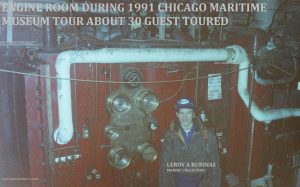
In 1991 she was discovered by a youth and with much luck and with the cooperation of the Chicago Maritime Society and Illinois Port Authority 30 museum guests toured and photographed this aging carrier, noting her riveted hull, steam machinery, and victorian wood work. Between 1991-1993, I a freelance photographer documented most of this ship on film. I rode a Schwinn bicycle two hours each way from Bridgeport in Chicago to the ship on 130th Ave and the Calumet River. In 1992 after shooting some film the crew, consisting of Max, Greg and John, advised me of an upcoming storm. I made my way home only to be caught in a fierce wind storm on 31st beach. Like the storm of 1967 people were harmed. At a construction site three workers were injured when a wall fell on them, a woman was struck and killed by lightning in the Chicago area. DeLaSalle high school on Wabash Ave lost a large section of roof and some rooms suffered water damage. The J. B. Ford was fine because the crew prepared by securing her doors and hatches. My tours were rewarding as all of the Ford s nautical goodies were intact, the brass plaques, steam whistles, and other memoirs that make for good den decorations. I toured the engine room with Norman Martinson, a Fleet Engineer for Inland Lakes Management who managed the ship for Lafarge Corp. He gave valuable information on how the ship functioned. He explained what the handles on the engine were used for, and what the brass gauges measured. As a cadet for GLMA I toured the J.B. Ford again while the cement carrier Alpena was unloading a cargo of cement into her in the summer of 1996. I noticed a handful of items were missing, such as the engine revolution counter, whistle, and name boards. In 1996 Inland Lakes Management transferred ownership of the vessel to LaFarge Corp.
In 2001 La Farge no longer needed the ship in S. Chicago, due to a much larger land silo being completed there. The J. B. Ford under tow from May 31st to June 5th was lead up to Superior,WI just across from Duluth,MN where she continued service as a cement silo. In 2004 the J.B. Ford was dry docked at Fraser shipyards, where her hull was painted, and her sea chest ports were welded shut. The large propeller was also cut off from the hull to ensure water tightness.
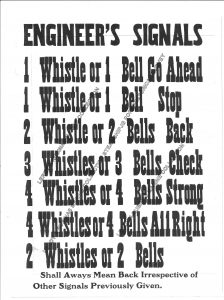
In the year of 2006 a few things occurred, LaFarge Corp. celebrated their 50th year of service, the same number of years the J.B. Ford was in the cement fleet, and some small items from the vessel s lifeboats and engine room were sold on on-line auctions during the summer months. The ship s Starboard lifeboat and wooden steering wheel were put on display by LaFarge Corp. at the Bessemer Museum in Alpena,MI from February to September. Also in Sept. the J.B. Ford was moved to another dock in Superior,WI to make room for a larger carrier which is currently being used as a cement silo. The J. B. Ford was still docked in Superior , WI as of 2014. In November of 2006 www.steamshipjbfordhistoricalsurvey.com was created in order to raise awareness of this aging lake carrier and to promote her story through the sale of pastal painting prints by Catherine Lorech. Some of the items listed on internet auctions from the J. B. Ford were loaned to Lower Lakes Historical Society in Buffalo, N. Y. Museum guest have the opportunity to see items like one of the name boards from the ship. Interested parties may visit www.llmhs.org .
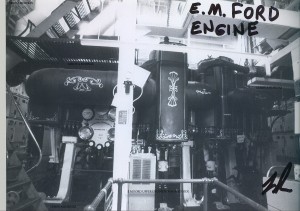
In November of 2008 another old fleetmate the E. M. Ford(1898) was sold to Purvis Marine of Canada to be reduced to scrap. As of April 2009 the E. M. was docked across the river from the S.S. Valley Camp Museum. The E. M. was eventually reduced to scrap. LaFarge N. A. awarded some marine artifacts from the E. M. to some individuals whom were associated with various Saginaw, MI non-profit groups. Months later many of these items ended up on internet auctions. A gear mounted on the propellor shaft of the E. M. was pulled from the idle J. B. Ford while they were docked together in Milwaukee,WI in 1985. This gear was used to turn over the main engine when engineer’s were making repairs. Thus part of the J. B. Ford was scrapped when the E. M. was broken up.
Over the summer of 2010 Steve Haverty Jr. with help from Richard Jenkins & Kevin J. Foster and myself started the non-profit group Great Lakes Steamship Society. Steve the president of the group began raising interest on a facebook page and Great Lakes Steamship Society was incorporated in MN. GLSS can be contacted with the latest updates on their web page www.greatlakessteamshipsociety.org or www.jbford.org . GLSS has made contact with LaFarge North America in an effort to preserve this vessel for future generations. In June of 2013 the president of GLSS Inc. contacted Joe Lombardi, a well respected marine surveyor to survey the J.B. Ford. Between June 30, 2013 and July 1, 2013 this survey was performed, the report never finalized.
In July 2014 the Duluth, MN newspaper reported GLSS has abandoned efforts to save the J. B. Ford as a whole. As of September 2014 LaFarge North America has been actively seeking bids to scrap the vessel. GLSS is working with LaFarge to save as much of the vessel as possible. LaFarge North America is not open to or commited to sell any items off the vessel to any individuals.
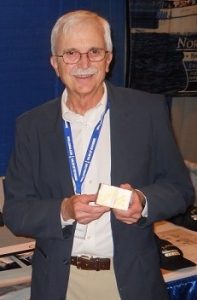
On October 9th 2015 the J. B. Ford was towed from Superior, WI across the harbor to Duluth, MN where the ship will be broken up for scrap.
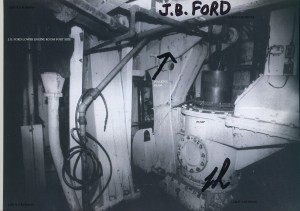
On November 5th 2015 after a long ten year run the decision was made not to renew steamshipjbfordhistoricalsurvey . com. On November 27th 2015 steamshipjbfordhistoricalsurvey moved to .org. The J. B. Ford is truley a gem of Great Lakes Heritage. It is sad to see it broken up for scrap.
In the spring of 2017 a number of artifacts including doors, sinks, and portholes were removed by Azcon Metals from the vessel for resale. During this time the vessel was abated of asbestos. Crews are working to prepare the vessel to be broken up this year. Plans were under way to see if the ship’s triple expansion steam engine could be saved at Canal Park Museum Duluth, MN. Those plans included a new building to house the engine, but as of July 2017 some details regarding engine removal could not be worked out. As of Sept. 2017 the main steam engine from 1903 was further prepared to be scrapped. The original main engine, along with seven deck winch engines, a WW2 era liberty ship steam steering engine, an a Nordberg six cylinder diesel engine will be broken up for scrap. During 2018 the J. B. Ford remained at Azcon scrap dock. In late 2018 the decision was made to no longer be listed as board member with GLSS Inc.. They are still on the web and can be linked in the text above. In April of 2019 it was relayed that scraping of the ship could possibly begin as early as June of 2019.
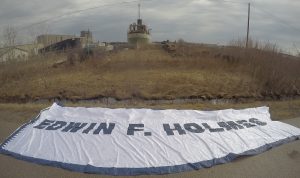
On April 24th 2019 a 27 foot long by 10 foot wide replica name pennant was photographed near the stern of the J. B. Ford. The pennant read “Edwin F. Holmes.” On May 31st 2019 I was able to interview Joseph Lombardi of Ocean Technical Services www.oceantechserv.com . I wanted to learn and share first hand an account of the 2013 J. B. Ford survey. He explained more about his view of the Ford in 2013 and reasons why the survey report was never finalized. A parting thought was that she is a special boat, with a rich history, and her hull was in great shape for her age.
On June 29, 2019 the whistle from the J. B. Ford was dedicated in ceremony at the Harsens Island Historical Society. Two years prior John Cameron Jr. offered the whistle to the society. He owned it for many years at his home on a lake near Grand Rapids, Michigan. John Cameron Jr. was gifted the whistle from Inland Lakes Management. Chuck Miller and Bobby Bryson retrieved the whistle and compressor from the donors home to bring over to Harsens Island. Plans were made by the society and money raised to build an addition to the museum to house a larger compressor and receiver tank. John Cameron Jr. and his brother Kenny were first to blow the whistle at the ceremony. To view the whistle and hear a voice from the past visit Harsens Island Historical Society https://harsensislandhistory.org.
The J. B. Ford is still intact during October of 2019, four full years has passed since being tied to the Azcon Metals dock. Given the current market conditions for scrap it is speculated that the J. B. Ford will still be around come 2020. On June 16, 2020 the vessel was moved along the dock, but still intact. This means there is still time to photograph a ship that collided in 1904 with the Steamer America now preserved in Isle Royale, and one that made it safe to Duluth in the Mataafa Storm of November 28, 1905 over 115 years ago. If the J. B. Ford remains up to October 2021 it would have spent 6 years tired to that dock, 20 years in the Twin Ports, and if it is still floating on December 12, 2021 then 118 years on the Great Lakes. On March 1st 2021 in the bitter cold local new outlets reported smoke, fire coming from the J. B. Ford. It appears breaking up of the vessel has begun for 2021. The vessel was slowly broken up stern first dragged onto the shore. There was hope among some that the forward cabins would be cut and saved. The pilothouse house was cut and pulled down into her cargo hold. In August of 2022 the last bit of bow section was cut up and brought onshore. At the end of that month none of the vessel was floating.
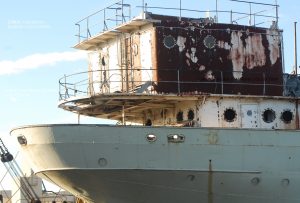
J B Ford at Azcon Metals yard 2017
note some portholes removed.
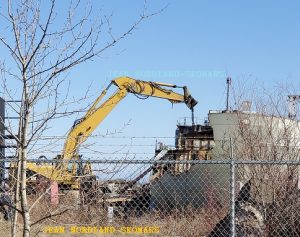
On August 14th 2023 although the majority of the main steam engine was broken up, two larger pieces of the crank were removed from the scrap yard via truck. These pieces were once part of the heaviest part of the engine, the crank shaft. Specifically the crank shaft part of the low pressure cylinder, and the crank shaft part of the intermediate cylinder. It is believed that the high pressure cylinder part of the crank shaft could already be scrapped and sold. Interestingly the high pressure cylinder part of the crank shaft was stamped on the connecting rod “329” and HP. This indicated the engine and ship it belonged to as well as where the connecting rod should be placed on the engine.
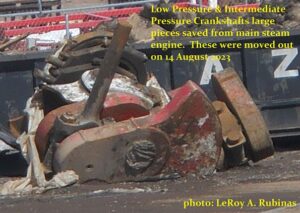
On August 20th, 2023 after 2 pm, a Steamship J. B. Ford history talk was held at the Harsen’s Island Historical Society. This museum has in their collection the main steam whistle from the J. B. Ford. Writers LeRoy A. Rubinas and Wes Oleszewski spoke about their history with this ship. The ship’s bell was on display for this event. The former counsel for Inland Lakes Management and donor of the whistle in 2017 John Cameron, Jr., added his insight. He explained the propeller for the J. B. Ford in 2003, was removed , so the ship could fall under USCG rules for a barge instead of a steamship.

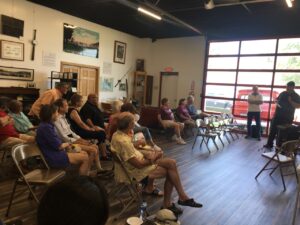
Between September 07-10, 2023 the Steamship J. B. Ford table was set-up between the reciprocating steam engine generator, and the main propulsion triple expansion steam engine saved from the passenger vessel SS Canadiana built in 1910. The author was available to not only speak about the ongoing painting and lighting project for the SS Canadian engine, but of the unique history of the Steamship J. B. Ford. At the time of this year’s 56th Steam Show in Alexander patrons were able to view changes to the SS Canadiana engine with fresh white paint on the lower framing, and 4 out of 8 Killark industrial lamps mounted and “Shining Brightly,” for the show. The author recalled early years of replacing bulbs of the Steamship J. B. Ford’s engine during his photo sessions from 1991-1993.
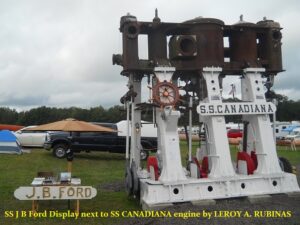
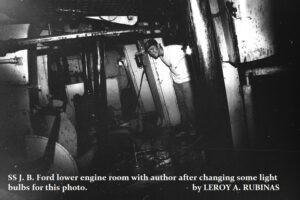
On November 11, 2023 the Steamship J. B. Ford table was present at the Duluth Entertainment Convention Complex for the annual fundraiser for Lake Superior Maritime Museum Association “Gales of November.” Proceeds help the association help Canal Park Maritime Museum. At the event a small heavy riveted piece of hull section was available for viewing, along with a wooden chair that joined the vessel for the crew’s lounge in March of 1980. The vacuum lever from the Triple Expansion Steam Engine was on display as well. A few individuals were allowed to sign the lever one of them being Frederick Stonehouse whom in 2015 wrote the book “The Last Laker.” This book featured photos from Great Lakes Steamship Society tour of the vessel in 2013.
During the show a couple rumors about the Steamship J. B. Ford were shared. One being that a contributing factor to why the main steam engine was not saved was due to crane operator’s not having pick points for the engine from 1903. You can decide if that is truth or not. Another rumor of which it is hoped will become true involves one of the Steamer’s surviving anchors. It has been heard that one might be donated to Canal Park Marine Museum to be displayed on the grounds. If this does come to pass, then the story that should be told would be one of the Steamer America which was struck by one in Duluth Harbor in 1904. The Steamer had five cabins wrecked, but she was allowed to depart for her mail run. The Holmes left the next day, it was one of her anchors that caused the damage. The America is preserved on Isle Royale waters and is very popular with the diving community.
This 2023 on December 12th at 12 noon Eastern Time marks the 120th Anniversary of her launching as the Edwin F. Holmes. Hear are two links for videos uploaded on the web marking this event. The vessel is no more, but some artifacts survive to address a large swath of Great Lakes Maritime and United States Industrial History.
Year 2024 Highlights
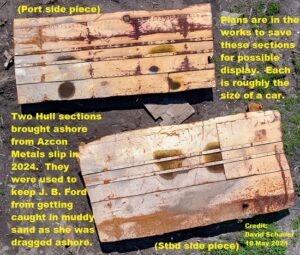
In the early spring the water levels were lower than normal revealing two large hull sections from the Steamship J. B. Ford in the Azcon Metals slip. While the vessel was being scrapped in 2021 two side sections were removed and placed in the slip to aid in pulling the hull ashore. One section was from Port and one from Starboard. These were roughly the size of a standard parking spot. The J. B. Ford hull was pulled up on shore slowly and these two parts helped keep the ship from snagging in the mud. In spring of 2024 these were placed on shore and negotiations are underway to see if they could be preserved in similar fashion to the hull sections of R.M.S. Titanic, and the bow section of the USS Wolverine. A couple organizations have showed interest, but it remains to be seen if they will go on public display.
In the month of September J. B. Ford table was at WNY Gas & Steam Association during their rally next to the 1910 vintage Detroit Shipbuilding Company engine from the long-scrapped SS Canadiana. During this same time the Association for Great Lakes Maritime History had their conference in Buffalo, N.Y. and guest were able to view the sign of the J. B. Ford at the Buffalo Harbor Museum, and a J. B. Ford table was present at the Buffalo Naval Park for members to learn more of J. B. Ford. A harbor cruise brought guest out to see and hear about her near sister the MacGilvray Shiras which in 1959 broke away from the still standing Concrete Central elevator and floated down the winding bends in the river until striking the Tewksbury which brought down and blocked the Cotter fire boat.
Purpose: This website was created in order to raise historical awareness about this historic lake freighter. Through a collection of photos, drawings, artifacts, vessel files, and sea stories it is planned to package this data into a book. My interest in this vessel started in 1991, For me this is a chance to see, to travel back in time to steel prop steamers of the November 28, 1905 storm on Lake Superior.
Sincerely, LEROY A. RUBINAS
